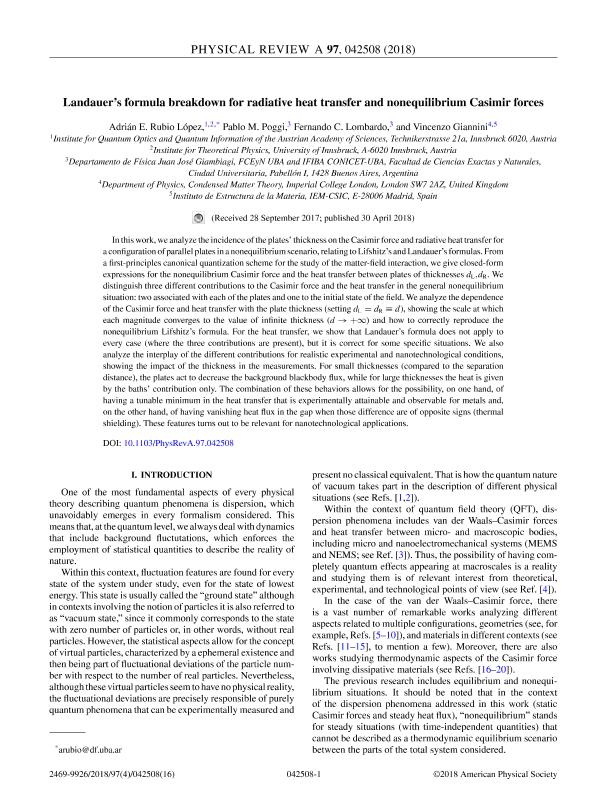Mostrar el registro sencillo del ítem
dc.contributor.author
Rubio López, Adrián E.
dc.contributor.author
Poggi, Pablo Matías

dc.contributor.author
Lombardo, Fernando Cesar

dc.contributor.author
Giannini, Vincenzo
dc.date.available
2023-08-14T14:07:09Z
dc.date.issued
2018-04
dc.identifier.citation
Rubio López, Adrián E.; Poggi, Pablo Matías; Lombardo, Fernando Cesar; Giannini, Vincenzo; Landauer's formula breakdown for radiative heat transfer and nonequilibrium Casimir forces; American Physical Society; Physical Review A: Atomic, Molecular and Optical Physics; 97; 4; 4-2018; 425081-4250816
dc.identifier.issn
1050-2947
dc.identifier.uri
http://hdl.handle.net/11336/208133
dc.description.abstract
In this work, we analyze the incidence of the plates' thickness on the Casimir force and radiative heat transfer for a configuration of parallel plates in a nonequilibrium scenario, relating to Lifshitz's and Landauer's formulas. From a first-principles canonical quantization scheme for the study of the matter-field interaction, we give closed-form expressions for the nonequilibrium Casimir force and the heat transfer between plates of thicknesses dL,dR. We distinguish three different contributions to the Casimir force and the heat transfer in the general nonequilibrium situation: two associated with each of the plates and one to the initial state of the field. We analyze the dependence of the Casimir force and heat transfer with the plate thickness (setting dL=dR≡d), showing the scale at which each magnitude converges to the value of infinite thickness (d→+) and how to correctly reproduce the nonequilibrium Lifshitz's formula. For the heat transfer, we show that Landauer's formula does not apply to every case (where the three contributions are present), but it is correct for some specific situations. We also analyze the interplay of the different contributions for realistic experimental and nanotechnological conditions, showing the impact of the thickness in the measurements. For small thicknesses (compared to the separation distance), the plates act to decrease the background blackbody flux, while for large thicknesses the heat is given by the baths' contribution only. The combination of these behaviors allows for the possibility, on one hand, of having a tunable minimum in the heat transfer that is experimentally attainable and observable for metals and, on the other hand, of having vanishing heat flux in the gap when those difference are of opposite signs (thermal shielding). These features turns out to be relevant for nanotechnological applications.
dc.format
application/pdf
dc.language.iso
eng
dc.publisher
American Physical Society

dc.rights
info:eu-repo/semantics/openAccess
dc.rights.uri
https://creativecommons.org/licenses/by-nc-sa/2.5/ar/
dc.subject
Casimir Effect
dc.subject
Non-equilibrium Casimir physics
dc.subject
Landauer?s formula
dc.subject.classification
Física de Partículas y Campos

dc.subject.classification
Ciencias Físicas

dc.subject.classification
CIENCIAS NATURALES Y EXACTAS

dc.title
Landauer's formula breakdown for radiative heat transfer and nonequilibrium Casimir forces
dc.type
info:eu-repo/semantics/article
dc.type
info:ar-repo/semantics/artículo
dc.type
info:eu-repo/semantics/publishedVersion
dc.date.updated
2019-10-22T18:01:08Z
dc.identifier.eissn
2469-9934
dc.journal.volume
97
dc.journal.number
4
dc.journal.pagination
425081-4250816
dc.journal.pais
Estados Unidos

dc.journal.ciudad
New York
dc.description.fil
Fil: Rubio López, Adrián E.. Institute For Quantum Optics And Quantum Information Of; Austria
dc.description.fil
Fil: Poggi, Pablo Matías. Consejo Nacional de Investigaciones Científicas y Técnicas. Oficina de Coordinación Administrativa Ciudad Universitaria. Instituto de Física de Buenos Aires. Universidad de Buenos Aires. Facultad de Ciencias Exactas y Naturales. Instituto de Física de Buenos Aires; Argentina
dc.description.fil
Fil: Lombardo, Fernando Cesar. Universidad de Buenos Aires. Facultad de Ciencias Exactas y Naturales. Departamento de Física; Argentina. Consejo Nacional de Investigaciones Científicas y Técnicas. Oficina de Coordinación Administrativa Ciudad Universitaria. Instituto de Física de Buenos Aires. Universidad de Buenos Aires. Facultad de Ciencias Exactas y Naturales. Instituto de Física de Buenos Aires; Argentina
dc.description.fil
Fil: Giannini, Vincenzo. Imperial College. Theoretical Physics Group; Reino Unido. Consejo Superior de Investigaciones Científicas; España
dc.journal.title
Physical Review A: Atomic, Molecular and Optical Physics

dc.relation.alternativeid
info:eu-repo/semantics/altIdentifier/url/https://journals.aps.org/pra/abstract/10.1103/PhysRevA.97.042508
dc.relation.alternativeid
info:eu-repo/semantics/altIdentifier/doi/http://dx.doi.org/10.1103/PhysRevA.97.042508
Archivos asociados
